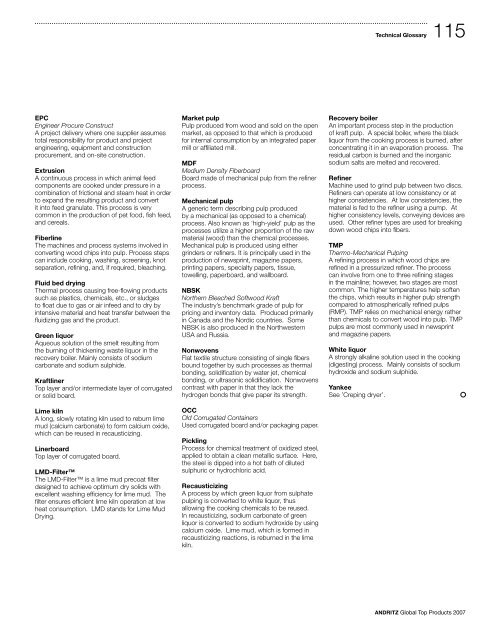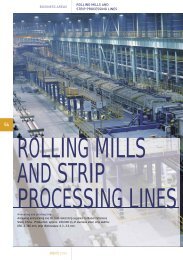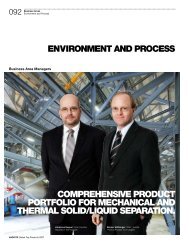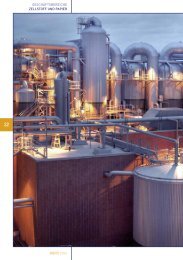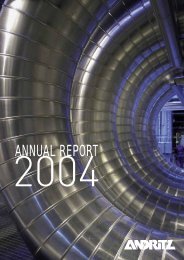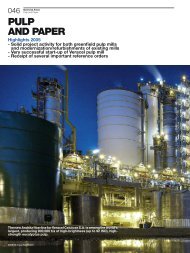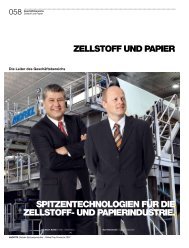Download as pdf - andritz business areas
Download as pdf - andritz business areas
Download as pdf - andritz business areas
- No tags were found...
You also want an ePaper? Increase the reach of your titles
YUMPU automatically turns print PDFs into web optimized ePapers that Google loves.
Technical Glossary<br />
115<br />
EPC<br />
Engineer Procure Construct<br />
A project delivery where one supplier <strong>as</strong>sumes<br />
total responsibility for product and project<br />
engineering, equipment and construction<br />
procurement, and on-site construction.<br />
Extrusion<br />
A continuous process in which animal feed<br />
components are cooked under pressure in a<br />
combination of frictional and steam heat in order<br />
to expand the resulting product and convert<br />
it into feed granulate. This process is very<br />
common in the production of pet food, fish feed,<br />
and cereals.<br />
Fiberline<br />
The machines and process systems involved in<br />
converting wood chips into pulp. Process steps<br />
can include cooking, w<strong>as</strong>hing, screening, knot<br />
separation, refining, and, if required, bleaching.<br />
Fluid bed drying<br />
Thermal process causing free-flowing products<br />
such <strong>as</strong> pl<strong>as</strong>tics, chemicals, etc., or sludges<br />
to float due to g<strong>as</strong> or air infeed and to dry by<br />
intensive material and heat transfer between the<br />
fluidizing g<strong>as</strong> and the product.<br />
Green liquor<br />
Aqueous solution of the smelt resulting from<br />
the burning of thickening w<strong>as</strong>te liquor in the<br />
recovery boiler. Mainly consists of sodium<br />
carbonate and sodium sulphide.<br />
Kraftliner<br />
Top layer and/or intermediate layer of corrugated<br />
or solid board.<br />
Lime kiln<br />
A long, slowly rotating kiln used to reburn lime<br />
mud (calcium carbonate) to form calcium oxide,<br />
which can be reused in recausticizing.<br />
Linerboard<br />
Top layer of corrugated board.<br />
LMD-Filter<br />
The LMD-Filter is a lime mud precoat filter<br />
designed to achieve optimum dry solids with<br />
excellent w<strong>as</strong>hing efficiency for lime mud. The<br />
filter ensures efficient lime kiln operation at low<br />
heat consumption. LMD stands for Lime Mud<br />
Drying.<br />
Market pulp<br />
Pulp produced from wood and sold on the open<br />
market, <strong>as</strong> opposed to that which is produced<br />
for internal consumption by an integrated paper<br />
mill or affiliated mill.<br />
MDF<br />
Medium Density Fiberboard<br />
Board made of mechanical pulp from the refiner<br />
process.<br />
Mechanical pulp<br />
A generic term describing pulp produced<br />
by a mechanical (<strong>as</strong> opposed to a chemical)<br />
process. Also known <strong>as</strong> ‘high-yield’ pulp <strong>as</strong> the<br />
processes utilize a higher proportion of the raw<br />
material (wood) than the chemical processes.<br />
Mechanical pulp is produced using either<br />
grinders or refiners. It is principally used in the<br />
production of newsprint, magazine papers,<br />
printing papers, specialty papers, tissue,<br />
towelling, paperboard, and wallboard.<br />
NBSK<br />
Northern Bleached Softwood Kraft<br />
The industry’s benchmark grade of pulp for<br />
pricing and inventory data. Produced primarily<br />
in Canada and the Nordic countries. Some<br />
NBSK is also produced in the Northwestern<br />
USA and Russia.<br />
Nonwovens<br />
Flat textile structure consisting of single fibers<br />
bound together by such processes <strong>as</strong> thermal<br />
bonding, solidification by water jet, chemical<br />
bonding, or ultr<strong>as</strong>onic solidification. Nonwovens<br />
contr<strong>as</strong>t with paper in that they lack the<br />
hydrogen bonds that give paper its strength.<br />
OCC<br />
Old Corrugated Containers<br />
Used corrugated board and/or packaging paper.<br />
Pickling<br />
Process for chemical treatment of oxidized steel,<br />
applied to obtain a clean metallic surface. Here,<br />
the steel is dipped into a hot bath of diluted<br />
sulphuric or hydrochloric acid.<br />
Recausticizing<br />
A process by which green liquor from sulphate<br />
pulping is converted to white liquor, thus<br />
allowing the cooking chemicals to be reused.<br />
In recausticizing, sodium carbonate of green<br />
liquor is converted to sodium hydroxide by using<br />
calcium oxide. Lime mud, which is formed in<br />
recausticizing reactions, is reburned in the lime<br />
kiln.<br />
Recovery boiler<br />
An important process step in the production<br />
of kraft pulp. A special boiler, where the black<br />
liquor from the cooking process is burned, after<br />
concentrating it in an evaporation process. The<br />
residual carbon is burned and the inorganic<br />
sodium salts are melted and recovered.<br />
Refiner<br />
Machine used to grind pulp between two discs.<br />
Refiners can operate at low consistency or at<br />
higher consistencies. At low consistencies, the<br />
material is fed to the refiner using a pump. At<br />
higher consistency levels, conveying devices are<br />
used. Other refiner types are used for breaking<br />
down wood chips into fibers.<br />
TMP<br />
Thermo-Mechanical Pulping<br />
A refining process in which wood chips are<br />
refined in a pressurized refiner. The process<br />
can involve from one to three refining stages<br />
in the mainline; however, two stages are most<br />
common. The higher temperatures help soften<br />
the chips, which results in higher pulp strength<br />
compared to atmospherically refined pulps<br />
(RMP). TMP relies on mechanical energy rather<br />
than chemicals to convert wood into pulp. TMP<br />
pulps are most commonly used in newsprint<br />
and magazine papers.<br />
White liquor<br />
A strongly alkaline solution used in the cooking<br />
(digesting) process. Mainly consists of sodium<br />
hydroxide and sodium sulphide.<br />
Yankee<br />
See ’Creping dryer’.<br />
ANDRITZ Global Top Products 2007


